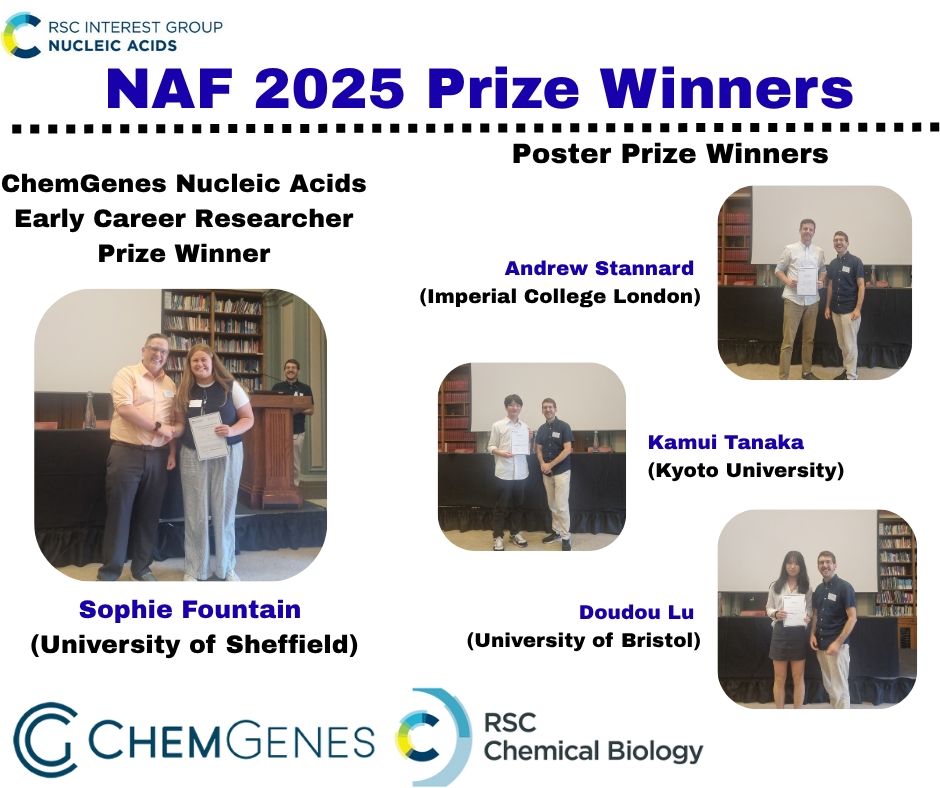MCGalan Lab
@mcgalanlab.bsky.social
430 followers
220 following
34 posts
Professor of Organic and Biological Chemistry Interests in Organic Synthesis, Catalysis, Nanomaterials, G4s and Chemical Biology -
Based at School of Chemistry, University of Bristol, UK. http://galanresearch.com
Posts
Media
Videos
Starter Packs
MCGalan Lab
@mcgalanlab.bsky.social
· Aug 7

Bridged Azobenzene Exhibits Fully Reversible Photocontrolled Binding to a G-Quadruplex DNA/Duplex Junction
The ability to selectively control DNA conformation using light as an external stimulus offers unique opportunities to control specific DNA sequences in biological settings and to develop nucleotide-b...
pubs.acs.org
MCGalan Lab
@mcgalanlab.bsky.social
· Jul 30
MCGalan Lab
@mcgalanlab.bsky.social
· Jul 17

Carbon Dots as an Emergent Class of Sustainable Antifungal Agents
Carbon-based functional nanomaterials with distinct photoluminescent properties have gained significant attention for their diverse applications in bioimaging, biomedicine, and antimicrobial treatment...
pubs.acs.org
Reposted by MCGalan Lab
Reposted by MCGalan Lab
Robin Bedford
@bedcatalysis.bsky.social
· Jul 11
MCGalan Lab
@mcgalanlab.bsky.social
· Jul 3

Carbon Dots as an Emergent Class of Sustainable Antifungal Agents
Carbon-based functional nanomaterials with distinct photoluminescent properties have gained significant attention for their diverse applications in bioimaging, biomedicine, and antimicrobial treatment...
pubs.acs.org
Reposted by MCGalan Lab
MCGalan Lab
@mcgalanlab.bsky.social
· Jun 12
MCGalan Lab
@mcgalanlab.bsky.social
· Jun 11

Improved ESI-MS Sensitivity via an Imidazolium Tag (DAPMI-ITag) for Precise Sialic Acid Detection in Human Serum and CMAH-Null Mouse Tissues
Sialic acids (Sias), consisting primarily of N-acetylneuraminic acid (Neu5Ac) and N-glycolylneuraminic acid (Neu5Gc), play crucial roles in many biological processes. The detection and quantification of Sias are essential for understanding their roles in health and disease progression. Although numerous techniques have been developed to enhance the specificity and sensitivity of Sias analysis, traditional methods such as derivatization with fluorescent tags coupled with HPLC-MS analysis often suffer from low limits of detection, limiting the quantification of Sias in trace samples. Here, we introduce DAPMI, a novel imidazolium-based ITag for sensitive Sia detection. We demonstrate its utility in the detection and quantification of Sia composition in human serum, and in different tissues from CMAH (cytidine monophosphate-N-acetylneuraminic acid hydroxylase) knockout mice, using ESI-MS analysis and with a limit of detection (LOD) down to the low fmol range. The results showed that both Neu5Ac and Neu5Gc were present in varying proportions in wild-type mice and CMAH heterogeneous mice. Trace amounts of Neu5Gc were also detected in the tissues of CMAH null homogeneous mice (CMAH–/−) and in human blood serum using ESI-ToF-MS, suggesting its presence may be linked to dietary intake of Neu5Gc-containing foods, as Neu5Gc cannot be synthesized endogenously in CMAH–/– mice, and in humans. The DAPMI-ITag and the labeling technology developed in this study significantly improve the sensitivity of Sias detection compared to conventional tags such as o-phenylenediamine (OPD), and provide a new chemical tool for the exploration of Sias’ biological roles and their use as biomarkers in different human conditions.
pubs.acs.org
Reposted by MCGalan Lab
MCGalan Lab
@mcgalanlab.bsky.social
· May 27

Cu(I)-Catalyzed Stereoselective Glycosylation of “Electron-Deficient” Glycals
An efficient and mild Cu(I)-catalyzed Michael-type conjugate addition for 2-nitro glycals to access O-, S-, and C-glycosides with high stereoselectivity is reported. Under optimized conditions, nitrog...
pubs.acs.org
MCGalan Lab
@mcgalanlab.bsky.social
· Apr 10

Carbohydrates An Important link between chemistry, biology and industries - American Chemical Society
A virtual symposium of ACS Spring 2025 programmed at convenient day times of multiple regions, including the latest in organometallic chemistry and catalysis.
www.acs.org



























